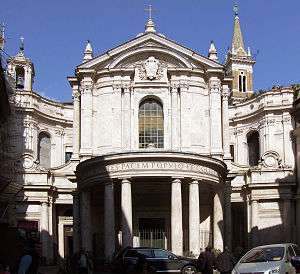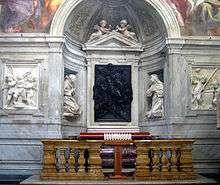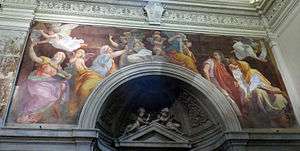Santa Maria della Pace

Santa Maria della Pace is a church in Rome, central Italy, not far from Piazza Navona. The building lies in rione Ponte.
History
The current building was built on the foundations of the pre-existing church of Sant'Andrea de Aquarizariis[1] in 1482, commissioned by Pope Sixtus IV. The church was rededicated to the Virgin Mary to remember a miraculous bleeding of a Madonna image there in 1480. The author of the original design is not known, though Baccio Pontelli has been proposed.

In 1656–67 Pope Alexander VII had the edifice restored by Pietro da Cortona, who also added the famous Baroque façade projecting from its concave wings: this, devised to simulate a theatrical set, has two orders and is entered by a semi-circular pronaos with paired Doric columns. The church presses forward almost to fill its tiny piazza; several houses had to be demolished by Pietro da Cortona to create even this miniature trapezoidal space. This newly formed piazza, focussed on the church facade even in its architectural detailing, had the additional benefits of facilitating the turning of coaches which had become so fashionable with the Roman nobility of the time and creating an ingenious unified ensemble of the church in its urban setting.[2] The play of concave and convex forms at varying scales in and around the predominant main facade masks the neighbouring buildings, extends the apparent breadth of the facade and so increases the visual impact on the spectator physically confined by the small trapezoidal piazza. The monumental effect of the plasticity of forms, spatial layering and chiarascuro lighting effects belies the actual scale of this urban intervention.
The inscription around the porch architrave is taken from Psalm 72: SUSCIPIANT MONTES PACEM POPULO ET COLLES IUSTITIAM ("The mountains shall bring peace to the people; and the hills, justice"). This reference to the 'mountains' of the coat of arms of the Chigi family, to which Alexander VII belonged, is presumably an allusion to the benefits of his papal reign. Oak leaf motifs, another Chigi family emblem, can also be found on the facade. On the upper facade, Cortona had the curved travertine panels cut to make grained matching patterns, in an unusual use of this particular material. Through the tall central window, the circular window of the Quattrocento church facade is visible.
Interior
The interior, which can be reached from the original fifteenth-century door, has a short nave with cruciform vaulting and a tribune surmounted by a cupola. Cortona articulated the interior of the dome with octagonal coffering and a series of ribs radiating from the lantern. This is an early example of combining these two forms of dome decoration and was employed by Gianlorenzo Bernini in his later churches at Ariccia and Castelgandolfo.[3]
Carlo Maderno designed the high altar (1614) to enframe the venerable icon of the Madonna and Child.
Chigi Chapel

Raphael began to fresco the Four Sibyls receiving angelic instruction (1514) above the arch of the Chigi Chapel, commissioned by Agostino Chigi, the papal banker.[4] The Deposition over the altar is by Cosimo Fancelli.
Cesi and Ponzetti Chapels
The second chapel on the right, the Cesi Chapel, was designed by Antonio da Sangallo the Younger, and has a very fine Renaissance decoration on the external arch by Simone Mosca, as well as two small frescoes, the Creation of Eve and the Original Sin by Rosso Fiorentino.
The first chapel on the left (Ponzetti Chapel) has noteworthy Renaissance frescoes by Baldassarre Peruzzi, who is better known as an architect. The second chapel has marble taken from the ruins of the Temple of Jupiter Capitolinus.
The tribune has paintings by Carlo Maratta, Peruzzi, Orazio Gentileschi, Francesco Albani and others.
A main feature of the church and monastery complex is the Bramante cloister. Built in 1500-1504 for Cardinal Oliviero Carafa, it was the first work of Donato Bramante in the city. It has two levels: the first is articulated by shallow pilasters set against an arcade; the second also has pilasters set against an arcade which is vertically continuous with the lower storey, but with columns located in between each arch span.
Gallery
-
Dome
-

Bramante cloister
-
Bramante cloister
See also
Notes
- ↑ Aquarizariis: "of the water carriers" on whom Rome depended after the aqueducts were broken.
- ↑ Anthony Blunt, Guide to Baroque Rome, Granada, 1982, p. 103
- ↑ A. Blunt, 1982, p. 104
- ↑ Unfinished by Raphael at his death (1520), the frescoes were completed based on his drawings by Sebastiano del Piombo. Raphael's assistant Timoteo Viti painted the four Prophets.
References
- Gizzi, Federico (1994). Le chiese rinascimentali di Roma. Rome: Newton Compton.
External links
| Wikimedia Commons has media related to Santa Maria della Pace (Rome). |
Coordinates: 41°54′00″N 12°28′18″E / 41.89987°N 12.47164°E
|